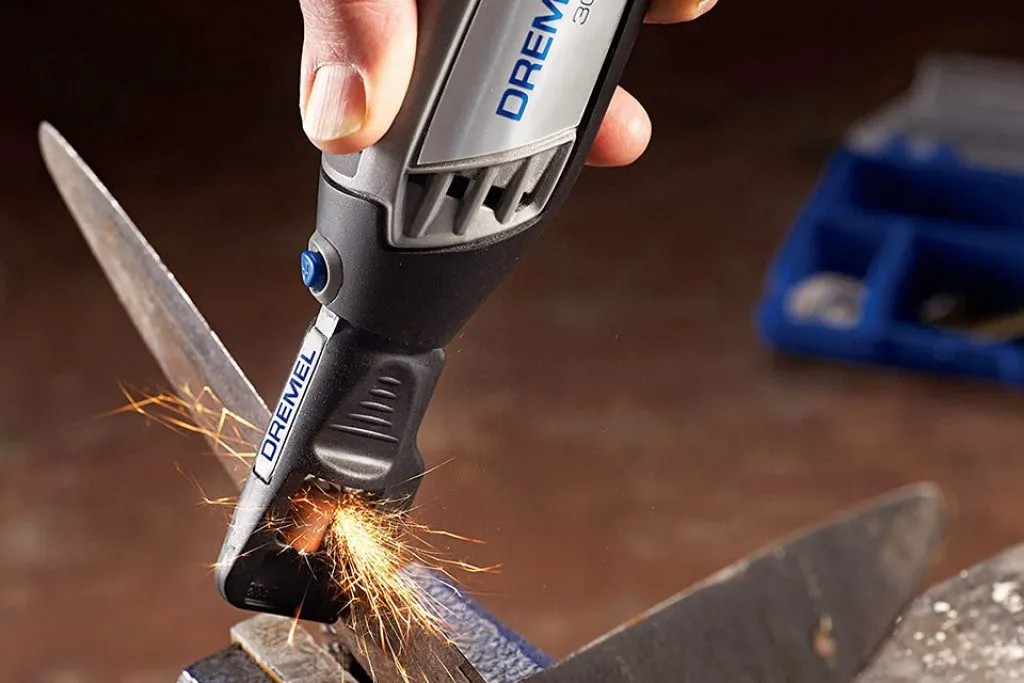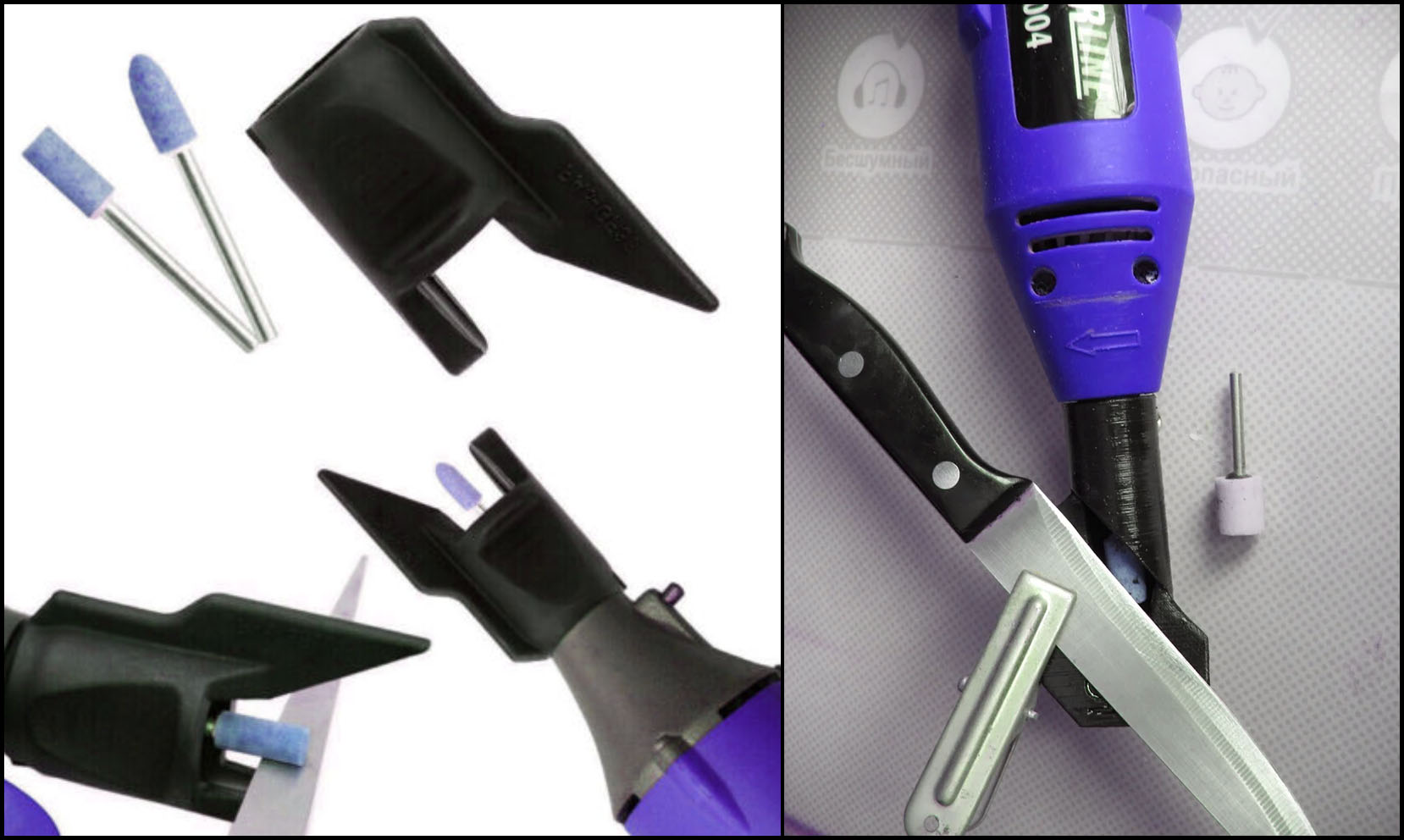To sharpen knives with a Dremel, first, secure the knife in a vise and put on safety goggles. Then, use a Dremel rotary tool equipped with a grinding stone to carefully sharpen the blade.
Sharpening knives with a Dremel can be a quick and effective way to maintain blade sharpness. Whether you are a professional chef or a DIY enthusiast, having a sharp knife is essential for efficient and safe cutting. Using a Dremel rotary tool to sharpen knives allows for precision and control, resulting in a sharp and durable edge.
In this guide, we will explore the step-by-step process of sharpening knives with a Dremel, along with some tips for achieving optimal results. By following these instructions, you can ensure that your knives remain sharp and ready for any cutting task.

Contents
Introduction To Knife Sharpening With A Dremel
Why Use A Dremel?
Using a Dremel for sharpening knives offers precision and control, resulting in a sharp, durable edge. The Dremel’s versatility allows for various attachments to cater to different blade types and materials, making it a versatile tool for knife sharpening.
Safety First: Preparing Your Workspace
Before starting, ensure your workspace is well-ventilated and free of clutter. Use safety goggles and gloves to protect yourself from metal shards and debris. Additionally, secure the knife in a stable position to prevent any accidents during the sharpening process.
Understanding The Dremel Tool
Discover how to effectively sharpen knives using a Dremel tool. Learn the precise technique for achieving razor-sharp edges effortlessly. Master the art of knife sharpening with the versatile Dremel tool in your toolkit.
If you’re looking for a versatile and efficient tool to sharpen your knives, a Dremel tool might be the perfect solution. Dremel tools are rotary tools that come with a range of attachments and accessories that allow you to perform various tasks, including sharpening knives.
However, before you start sharpening your knives with a Dremel tool, it’s essential to understand the tool’s types and how to choose the right attachment.
Types Of Dremel Models
Dremel tools come in different models, each with its own unique features. The most common types of Dremel models are the corded models and the cordless models.
Corded models are more powerful and suitable for heavy-duty tasks, while cordless models are more portable and convenient for light-duty tasks. Some of the popular Dremel models include the Dremel 4000, Dremel 4300, and Dremel 8220.
Choosing The Right Attachment
Choosing the right attachment is crucial when it comes to sharpening knives with a Dremel tool. The most suitable attachment for sharpening knives is the grinding stone attachment.
Grinding stone attachments come in different shapes and sizes, such as cylindrical, round, and conical, and are made of various materials, such as aluminum oxide and silicon carbide.
It’s essential to choose the right size and shape of the grinding stone attachment depending on the size and shape of your knife blade.
Here are some tips to keep in mind when choosing the right attachment for your Dremel tool:
- Choose a grinding stone attachment made of a hard and durable material
- Choose an attachment that matches the size and shape of your knife blade
- Ensure the attachment is securely attached to the Dremel tool
In conclusion, understanding the Dremel tool is essential when it comes to sharpening knives. Choosing the right Dremel model and attachment is crucial for achieving the best results. With the right tools and techniques, you can sharpen your knives like a pro using a Dremel tool.
Preparing The Knife
Before sharpening a knife with a Dremel, it’s crucial to properly prepare the knife. This involves cleaning the knife and inspecting the blade to ensure it is in good condition for sharpening.
Cleaning The Knife
Start by cleaning the knife using soap and water to remove any dirt or residue. Dry the knife thoroughly before proceeding with the sharpening process.
Inspecting The Blade
Examine the blade for any nicks, chips, or damage that may need to be addressed before sharpening. Ensure the blade is securely in place and there are no loose parts.

Setting Up The Dremel
When it comes to sharpening knives, the Dremel rotary tool can be a versatile and efficient option. Setting up the Dremel correctly is crucial to ensure safe and effective knife sharpening. Here are the essential steps to follow when setting up the Dremel for sharpening knives.
Securing The Attachment
To begin, secure the appropriate sharpening attachment onto the Dremel rotary tool. Ensure that the attachment is tightly fastened to the tool to prevent any movement during the sharpening process.
Adjusting The Speed
Next, it is important to adjust the speed of the Dremel to suit the specific type of knife and the level of sharpening required. A higher speed setting may be suitable for sharpening dull blades, while a lower speed setting is ideal for finer sharpening.
Sharpening Techniques
When it comes to sharpening knives with a Dremel, mastering the sharpening techniques is crucial for achieving optimal results.
Proper angle and positioning, as well as the correct motion of the Dremel along the blade, are essential for effectively sharpening knives.
In this guide, we’ll delve into these sharpening techniques in detail to help you achieve razor-sharp edges on your knives.
Angle And Positioning
The correct angle and positioning of the Dremel are pivotal for sharpening knives effectively.
A consistent angle, typically between 15 to 20 degrees, should be maintained to ensure a precise and uniform sharpening process. Incorrect positioning may result in uneven sharpening and even damage to the blade.
Moving The Dremel Along The Blade
When moving the Dremel along the blade, it’s essential to maintain a steady and controlled motion. Using gentle, fluid strokes, move the Dremel along the entire length of the blade, ensuring even contact with the sharpening surface.
This technique helps in achieving a uniform and sharp edge without causing any unnecessary wear on the blade.

Common Mistakes To Avoid
To sharpen knives with a Dremel, avoid applying too much pressure or using the wrong attachment. Be cautious not to overheat the blade and maintain a consistent angle while grinding. Remember to wear safety goggles and gloves for protection during the sharpening process.
Applying Too Much Pressure
Exerting excessive force on the blade can lead to uneven sharpening and potential damage.
Overheating The Blade
Operating the Dremel at high speeds for prolonged periods can overheat the blade, affecting its temper.
Finishing Touches
Sharpening knives with a Dremel is an effective way to achieve precise and sharp edges. By using the appropriate attachments and techniques, you can quickly and easily restore the cutting power of your knives. With the right finishing touches, your knives will be ready for any culinary task.
Now that you have sharpened your knife with the Dremel, there are a few finishing touches that will ensure your knife stays sharp for longer. These final steps are just as important as the actual sharpening process, so don’t skip them.
Testing The Sharpness
Before you start using your newly sharpened knife, it’s important to test its sharpness. One simple way to do this is to try slicing a piece of paper. If the knife slices through the paper cleanly and easily, it’s sharp enough.
If it tears the paper or struggles to cut through, you’ll need to sharpen it a bit more. Repeat the sharpening process until you achieve the desired sharpness.
Oiling The Blade
Once you’re happy with the sharpness of your knife, it’s time to protect the blade. Oiling the blade after sharpening helps prevent rust and corrosion, keeping your knife in good condition for longer.
Use a food-safe oil like mineral oil or vegetable oil and apply a thin layer to the blade, making sure to cover the entire surface. After oiling, wipe off any excess oil with a clean cloth.
In conclusion, following these finishing touches after sharpening your knife with a Dremel will ensure your knife stays sharp and in good condition for longer. Testing the sharpness and oiling the blade are simple yet effective steps that shouldn’t be skipped.
Maintaining Your Dremel
To maintain your Dremel for sharpening knives, regularly clean the tool to remove any debris or residue. Keep the Dremel’s blades sharp by honing them with a sharpening stone or wheel attachment. Proper maintenance ensures optimal performance and longevity of your Dremel for knife sharpening.
Maintaining Your Dremel Cleaning After Use After using your Dremel for sharpening knives, it’s crucial to clean it thoroughly. To do this, unplug the Dremel and use a soft, dry cloth to wipe down the exterior, removing any dust, debris, or metal shavings.
For the interior, gently blow away any residual particles using compressed air, taking care not to damage any delicate components. Checking for Wear and Tear Regularly inspect your Dremel for signs of wear and tear, such as frayed cords, loose components, or damaged accessories.
Ensure that all the parts are securely in place and functioning properly. If you notice any issues, address them promptly to maintain the performance and longevity of your Dremel.
By following these maintenance tips, you can ensure that your Dremel remains in optimal condition, ready for the next time you need to sharpen your knives.
Frequently Asked Questions
Can I Sharpen A Knife With A Dremel?
Yes, you can sharpen a knife with a Dremel tool. It is efficient for quick touch-ups and sharpening tasks.
Which Dremel Bit Is Used For Sharpening?
Use a Dremel grinding stone or chainsaw sharpening attachment for sharpening tools like knives and scissors.
How To Sharpen Blades With A Rotary Tool?
To sharpen blades with a rotary tool, secure the blade and wear safety goggles. Use a sharpening stone or attachment and gently guide it along the edge.
Maintain a consistent angle and repeat as needed. Finally, remove any burrs with a honing stone for a sharp edge.
How To Use Dremel Sharpening Attachment?
To use the Dremel sharpening attachment, first attach it to your Dremel tool. Make sure the attachment is secure. Then, select the appropriate sharpening stone for your tool.
Turn on your Dremel and slowly guide the tool blade against the sharpening stone. Repeat until the desired sharpness is achieved.
Conclusion
Mastering the art of knife sharpening with a Dremel can be a game-changer for your culinary experience.
By following the right techniques and taking necessary precautions, you can achieve razor-sharp edges efficiently.
Embrace the process, practice regularly, and enjoy the satisfaction of effortlessly slicing through any ingredient.

